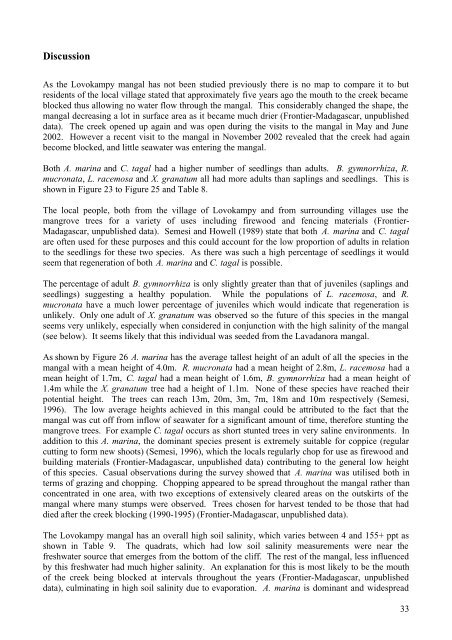Mangrove biodiversity survey south of the Onilahy River - Frontier ...
Mangrove biodiversity survey south of the Onilahy River - Frontier ...
Mangrove biodiversity survey south of the Onilahy River - Frontier ...
You also want an ePaper? Increase the reach of your titles
YUMPU automatically turns print PDFs into web optimized ePapers that Google loves.
Discussion<br />
As <strong>the</strong> Lovokampy mangal has not been studied previously <strong>the</strong>re is no map to compare it to but<br />
residents <strong>of</strong> <strong>the</strong> local village stated that approximately five years ago <strong>the</strong> mouth to <strong>the</strong> creek became<br />
blocked thus allowing no water flow through <strong>the</strong> mangal. This considerably changed <strong>the</strong> shape, <strong>the</strong><br />
mangal decreasing a lot in surface area as it became much drier (<strong>Frontier</strong>-Madagascar, unpublished<br />
data). The creek opened up again and was open during <strong>the</strong> visits to <strong>the</strong> mangal in May and June<br />
2002. However a recent visit to <strong>the</strong> mangal in November 2002 revealed that <strong>the</strong> creek had again<br />
become blocked, and little seawater was entering <strong>the</strong> mangal.<br />
Both A. marina and C. tagal had a higher number <strong>of</strong> seedlings than adults. B. gymnorrhiza, R.<br />
mucronata, L. racemosa and X. granatum all had more adults than saplings and seedlings. This is<br />
shown in Figure 23 to Figure 25 and Table 8.<br />
The local people, both from <strong>the</strong> village <strong>of</strong> Lovokampy and from surrounding villages use <strong>the</strong><br />
mangrove trees for a variety <strong>of</strong> uses including firewood and fencing materials (<strong>Frontier</strong>-<br />
Madagascar, unpublished data). Semesi and Howell (1989) state that both A. marina and C. tagal<br />
are <strong>of</strong>ten used for <strong>the</strong>se purposes and this could account for <strong>the</strong> low proportion <strong>of</strong> adults in relation<br />
to <strong>the</strong> seedlings for <strong>the</strong>se two species. As <strong>the</strong>re was such a high percentage <strong>of</strong> seedlings it would<br />
seem that regeneration <strong>of</strong> both A. marina and C. tagal is possible.<br />
The percentage <strong>of</strong> adult B. gymnorrhiza is only slightly greater than that <strong>of</strong> juveniles (saplings and<br />
seedlings) suggesting a healthy population. While <strong>the</strong> populations <strong>of</strong> L. racemosa, and R.<br />
mucronata have a much lower percentage <strong>of</strong> juveniles which would indicate that regeneration is<br />
unlikely. Only one adult <strong>of</strong> X. granatum was observed so <strong>the</strong> future <strong>of</strong> this species in <strong>the</strong> mangal<br />
seems very unlikely, especially when considered in conjunction with <strong>the</strong> high salinity <strong>of</strong> <strong>the</strong> mangal<br />
(see below). It seems likely that this individual was seeded from <strong>the</strong> Lavadanora mangal.<br />
As shown by Figure 26 A. marina has <strong>the</strong> average tallest height <strong>of</strong> an adult <strong>of</strong> all <strong>the</strong> species in <strong>the</strong><br />
mangal with a mean height <strong>of</strong> 4.0m. R. mucronata had a mean height <strong>of</strong> 2.8m, L. racemosa had a<br />
mean height <strong>of</strong> 1.7m, C. tagal had a mean height <strong>of</strong> 1.6m, B. gymnorrhiza had a mean height <strong>of</strong><br />
1.4m while <strong>the</strong> X. granatum tree had a height <strong>of</strong> 1.1m. None <strong>of</strong> <strong>the</strong>se species have reached <strong>the</strong>ir<br />
potential height. The trees can reach 13m, 20m, 3m, 7m, 18m and 10m respectively (Semesi,<br />
1996). The low average heights achieved in this mangal could be attributed to <strong>the</strong> fact that <strong>the</strong><br />
mangal was cut <strong>of</strong>f from inflow <strong>of</strong> seawater for a significant amount <strong>of</strong> time, <strong>the</strong>refore stunting <strong>the</strong><br />
mangrove trees. For example C. tagal occurs as short stunted trees in very saline environments. In<br />
addition to this A. marina, <strong>the</strong> dominant species present is extremely suitable for coppice (regular<br />
cutting to form new shoots) (Semesi, 1996), which <strong>the</strong> locals regularly chop for use as firewood and<br />
building materials (<strong>Frontier</strong>-Madagascar, unpublished data) contributing to <strong>the</strong> general low height<br />
<strong>of</strong> this species. Casual observations during <strong>the</strong> <strong>survey</strong> showed that A. marina was utilised both in<br />
terms <strong>of</strong> grazing and chopping. Chopping appeared to be spread throughout <strong>the</strong> mangal ra<strong>the</strong>r than<br />
concentrated in one area, with two exceptions <strong>of</strong> extensively cleared areas on <strong>the</strong> outskirts <strong>of</strong> <strong>the</strong><br />
mangal where many stumps were observed. Trees chosen for harvest tended to be those that had<br />
died after <strong>the</strong> creek blocking (1990-1995) (<strong>Frontier</strong>-Madagascar, unpublished data).<br />
The Lovokampy mangal has an overall high soil salinity, which varies between 4 and 155+ ppt as<br />
shown in Table 9. The quadrats, which had low soil salinity measurements were near <strong>the</strong><br />
freshwater source that emerges from <strong>the</strong> bottom <strong>of</strong> <strong>the</strong> cliff. The rest <strong>of</strong> <strong>the</strong> mangal, less influenced<br />
by this freshwater had much higher salinity. An explanation for this is most likely to be <strong>the</strong> mouth<br />
<strong>of</strong> <strong>the</strong> creek being blocked at intervals throughout <strong>the</strong> years (<strong>Frontier</strong>-Madagascar, unpublished<br />
data), culminating in high soil salinity due to evaporation. A. marina is dominant and widespread<br />
33
















